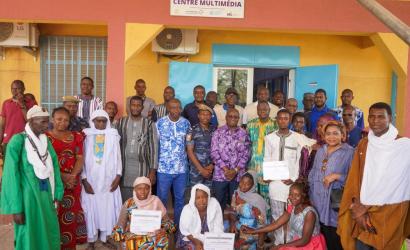Our strategy
ETC provides Services for Communities (S4C), enabling populations affected by crises to access life-saving information and communicate with humanitarians and each other through technology.
Information and communication are critical forms of aid without which local communities cannot access vital services or make informed decisions for themselves and their communities. ETC provides a range of technology services that improve the accessibility, affordability and usability of information and communication tools for local communities in sudden-onset and protracted crises. These services fall within two broad categories: (1) two-way communication between humanitarian and local communities and (2) access to information among local communities. Each category is discussed in detail below.
To inform service design, ETC conducts an Information, Communication and Technology Needs Assessment for Affected Populations. The assessment evaluates local communities’ information needs, access to telecommunications infrastructure, information consumption preferences, perceptions of humanitarian programs, digital literacy, affordability and education levels. Based on the assessment findings, ETC identifies the exact information, communication and technological needs of local communities, and designs projects that can best address these needs in each given context.
To ensure successful project implementation, ETC works with key stakeholders, including humanitarian agencies; donors; national and local governments; private sector; community leaders; journalists; broadcasters; faith-based organizations; Mobile Network Operators; Internet Service Providers; and local communities themselves.
1. TWO-WAY COMMUNICATION BETWEEN HUMANITARIAN AND LOCAL COMMUNITIES
Communication is a two-way process. Local communities and assistance providers are equal stakeholders in a humanitarian response. Local communities have the right to communicate with assistance providers before, during and after assistance is provided, and assistance providers are obliged to communicate with local communities.
ETC establishes effective two-way communication systems, including common feedback mechanisms (CFM) and various platform services, which facilitate dialogue between local communities and assistance providers, both local and international. Through these communication systems, the affected populations can interact with humanitarians in a coordinated manner and ensure their voices are heard by the responding agency. Humanitarians, in turn, get an insight into people’s needs; make better informed programming decisions; and promote collective accountability to local communities, while consolidating limited resources that are currently only available to humanitarian organizations individually.
2. ACCESS TO INFORMATION
Access to information is a form of assistance, which is as important as water, food and shelter. The affected communities have the right to accurate and appropriate information in order to get the help they need, locate missing family or friends, make informed decisions about their lives, achieve greater self-reliance and ultimately transform their future.
ETC enables access to information among the affected populations by providing the required technology and infrastructure that are desperately lacking in crises-affected countries, including data connectivity; calling services; power supply for device charging; and technology solutions for local radio broadcasters.




